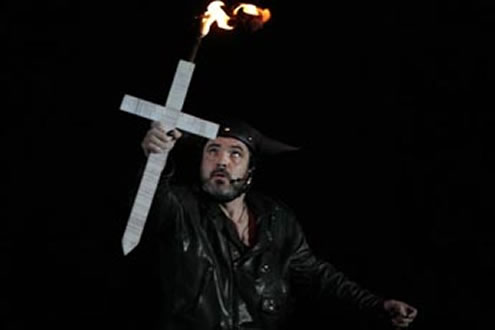

Release – 2006
A great new street spectacle
After the premiere at the Curitiba Festival came to São Paulo the production of the street show Hercules. With the experience of the street presentations, the groups Parlapatões and Pia Fraus decided to join in a project that, more than producing a spectacle, intended to break with the stigmatized thought which street theater is treated. A paradigm shift needed to resize and put into debate the importance of theater in the construction of citizenship. With a grandstand set up on the street for 800 people, Hercules was a spectacle of great proportions offered free of charge to the public.
With dramaturgy by Hugo Possolo (Parlapatões) and direction of Beto Andreetta (Pia Fraus), Hercules gathered the cast of the groups to the participants of the workshops of elaboration of the spectacle to tell the Greek epic in a contemporary vision.
The story of the demigod Heracles, better known by its Roman name, Hercules, challenged to perform twelve works, provided the plot and images for a grandiose, unprecedented scale in the country. In addition to the bleachers, the scene was composed of a cart of 13m whose sides were opened and closed on the scene; A scenic area of 20m x 15m, and 2 scaffolding (8m and 6m) made up the extraordinary dimension of an allegorical scenario. There were 26 on-stage actors with giant dolls and other unusual scene objects, such as a car, five bikes and an ambulance.
Often, the street shows are treated in a childish, almost naive manner. The intention was to break the limits of this surface treatment. In this assembly the option was to penetrate the mysteries of the great adventures of humanity: war, diseases, hunger, economic, religious or political power, among others. Like all Greek myths, the life of Hercules speaks beyond the fact, narrates human questions and challenges posed in all epochs. In this sense, the groups, in designing the script, sought to understand the challenges of the man of antiquity and to update these questions for the contemporary world. Today, the Lion of Nemea, which symbolizes strength, could well be seen as the force of economic power; The black birds of Lake of the Sphinx, which demonstrate the darkness of the challenges of difficult overcoming, can be compared to the hunger issue.
Parlapatões and Pia Fraus, respecting the characteristics of their styles, make up a unit with regard to direct communication with the audience, the use of circus resources, a constant scenic search and the maintenance of their respective repertoires. If, on the one hand, the Parlapatões apply themselves in a verbal mood and in the interaction of the public, on the other the visual keynote of the spectacles of the Pia Fraus, they stand as elements that integrate. In Hercules, plasticity and humor will dialogue with the gigantic dimensions of scenery and puppets.
In addition to the established allegories, it is noteworthy that the carnival is inspired by the search for a dramaturgy proper to the street. The erudite base of a mythological history is translated by elements of popular culture, such as the choir of the Erinias and Íficles, twin brother of Hercules, that narrate situating the spectator in the context of each scene.
The process of artistic research was the result of the Hercules project, A New Paradigm for the Street Theater, begun in August 2005, in the Program of Promotion to the Theater of the City of São Paulo. Several preparatory workshops were held with the participation of actors, producers, playwrights, set designers, costumers and advisors, many of whom were selected to participate in the staging.
Presentations in São Paulo were made possible by SESC São Paulo. The show also had the cultural support of CCR – Culture in Roads.
Credits
Dramaturgy: Hugo Possolo
Direction: Beto Andreetta
Direction Assistence: Wanderley Piras
Argument and scenographic design: Beto Andreetta, Hugo Possolo e Raul Barretto
Cast: Raul Barretto (Hércules), Claudinei Brandão (Hera e Mauro, o Centauro), Henrique Stroetter (Eristeu; Atená e Melanipe), Marcelo Castro (Íficles) e Hugo Possolo (Zeus e Hipólita).
Coral: Denise Venturini, Helena Cerello, Joana Mattei e Marília Carbonari (Erínias).
Actors Manipulators: André Martins, Camila Bevilacqua, Camila Ivo (Corça de Erínia e Gaia), Carol Di Deus (Alcmene), Dani New (Jesus), Dulce Coppedê (Mégara), Fabek Capreri (Bispo), Gilson César, J. E. Tico, Júlia Mascaro, Júlio César Dória, Mariana Goulart, Melina Menghimi, Patrícia Leonardélli, Pedro Negrão e Telma Negro.
Art Direction and Costumes: Hugo Possolo
Sound Track: Paulo Soveral
Ligthing: Tato Cobertt
Masks: José Toro Moreno
Vocal Preparation: Carlos Bauzys
Confection of the scenic allegories: Gustavo Pinheiro e Sidnei Caria
Assistence: Cláudia Muller, Daniel Segato, Francisco Wagner, Nana Oliveira, Yasmim Flores, Ricardo Siqueira, Alexandre Justino, Rodrigo Andrade, Juciê Batista, Dino Soto, Silas Caria
Circus Consulting: César Guimarães
Locksmith: Krismer Pepino e Rodnei Pepino
Seamstress: Leci de Andrade
Stage Director: Jackson Íris e Paulo Pansani
Counter-rules: Alexandre Justino, Gustavo Pinheiro e Marcos Loureiro
Sound Operator: Randolfo Neto
Ligth Operators: Christiano Resideri, André Silva Alves, Edmilson Aparecido Dalva, Rogério Pereira da Silva,Luiz Carlos Ribeiro Moraes
Production Director: Raul Barretto
Executive Production: Cristiani Zonzini
Production Assistence: Mariana Goulart, Júlio César Dória, Carol Di Deus e Vivian Dozono
Production Team: Calu Baroncelli, Daniela Renzo, Marco Antonio Senna, Raquel Araújo, Renata Bertelli
Communication and Press Office: Vivian Dozono
Visual Programming: Werner Schulz
Program Writing: Hugo Possolo e Vivian Dozono
Photos: Luiz Doroneto
Project carried out through Municipal Program of Promotion to the Theater To the City of São Paulo– Lei 13.279/02
Cultural Support:
CCR – Companhia de Concessões Rodoviárias
CCR – Cultura nas Estradas
Achievement:
Sesc São Paulo
Parlapatões, Patifes & Paspalhões
Pia Fraus
Cooperativa Paulista de Teatro